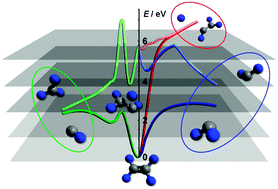Dissociation dynamics of fluorinated ethene cations: from time bombs on a molecular level to double-regime dissociators
Abstract
The dissociative photoionization mechanism of internal energy selected C2H3F+, 1,1-C2H2F2+, C2HF3+ and C2F4+ ![[double bond, length as m-dash]](https://www.rsc.org/images/entities/char_e001.gif) C bond. By modelling the breakdown diagrams and ion time-of-flight distributions using statistical theory, experimental 0 K appearance energies, E0, of the daughter ions have been determined. Both C2H3F+ and 1,1-C2H2F2+ are veritable time bombs with respect to dissociation viaHF loss, where slow dissociation over a reverse barrier is followed by an explosion with large kinetic energy release. The first dissociative ionization pathway for C2HF3 and C2F4 involves an atom migration across the C
C bond. By modelling the breakdown diagrams and ion time-of-flight distributions using statistical theory, experimental 0 K appearance energies, E0, of the daughter ions have been determined. Both C2H3F+ and 1,1-C2H2F2+ are veritable time bombs with respect to dissociation viaHF loss, where slow dissociation over a reverse barrier is followed by an explosion with large kinetic energy release. The first dissociative ionization pathway for C2HF3 and C2F4 involves an atom migration across the C![[double bond, length as m-dash]](https://www.rsc.org/images/entities/char_e001.gif) C bond, giving CF–CHF2+ and CF–CF3+, respectively, which then dissociate to form CHF2+, CF+ and CF3+. The nature of the F-loss pathway has been found to be bimodal for C2H3F and 1,1-C2H2F2, switching from statistical to non-statistical behaviour as the
C bond, giving CF–CHF2+ and CF–CF3+, respectively, which then dissociate to form CHF2+, CF+ and CF3+. The nature of the F-loss pathway has been found to be bimodal for C2H3F and 1,1-C2H2F2, switching from statistical to non-statistical behaviour as the


 Please wait while we load your content...
Please wait while we load your content...